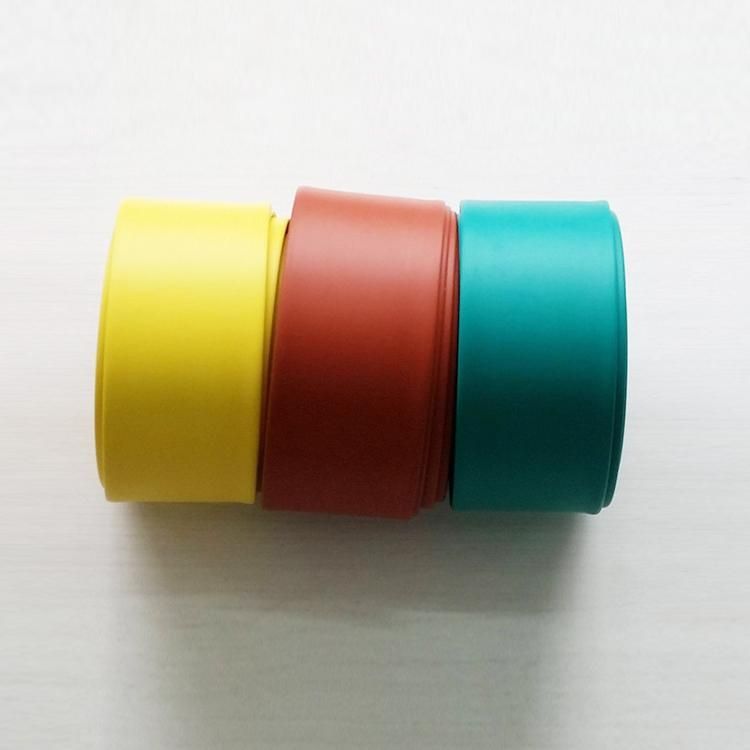The series of polyethylene heat-shrinkable tapes are designed for the corrosion protection of the welded joints of buried and overhead steel pipes and the insulation repair of the thermal insulation pipes. The steel pipe preheating temperature is 75°C, the maximum operating temperature is 80°C and it has the features as high mechanical strength and strong anti-aging ability.

What is Polyethylene Heat-shrinkable Tapes?
It is composed of radiation cross-linked polyolefin base material and special sealing hot melt adhesive. The special sealing hot melt adhesive can form a good bond with polyolefin base material, steel pipe surface and solid epoxy coating.
When WK-WSS polyethylene heat-shrinkable tape is installed under heating, the base material shrinks in the radial direction while the internal composite adhesive layer melts. It is tightly wrapped around the joint and together with the base material, then it forms a firm shape in the pipeline.
Polyethylene heat-shrinkable tape has excellent wear resistance, corrosion resistance, impact resistance, good UV resistance and light aging properties. In addition, the polyethylene heat-shrinkable tape is called a looper in the industry.
Compared with the heat-shrinkable sleeve, it is called a dead sleeve. In addition to the main body of the polyethylene heat-shrinkable tape, it is also equipped with a rubber strip and a fixing sheet. And the polyethylene heat-shrinkable tape is convenient large-scale production and construction are also much more convenient.
Features
- High mechanical strength and strong anti-aging ability
- Good environmental stress resistance
- Excellent bonding performance.
- Easy to use.
- Executive standard":
SY/T 0413-2002,NACE RP0303-2003 - Maximum operating temperature: 80℃
- Applicable external anti-corrosion coating: PE, FBE, PP
- Steel pipe preheating temperature: 75℃
- Recommended rust removal level: Sa 2.5
- Product specifications: the product can be used for all steel pipes of DN100-DN1000
- The thickness of the substrate is from 1.0-2.0mm, and the thickness of the glue layer is from 0.8-2.0mm
Technical Data
NO |
Property |
Test Method |
Typical Value |
|---|---|---|---|
Substrate |
/ |
/ |
/ |
1 |
Tensile Strength |
GB/T1040-92 |
24N/mm2 |
2 |
Ultimate Elongation |
GB/T1040-92 |
520% |
3 |
Dielectric strength |
GB/1408.1-99 |
33MV/ m |
4 |
Volume Resistivity |
GB/T1410-89 |
4.0x10Ω·m |
5 |
Water Absorption |
ASTM D570-2005 |
0.02 |
6 |
(150℃,21 day) |
GB/T1040-92 |
/ |
7 |
Tensile Strength |
/ |
14.6 N/mm2 |
8 |
Elongation at break |
/ |
300% |
9 |
UV aging resistance |
EN12068 |
/ |
10 |
Elongation at break |
/ |
480% |
Hot melt glue |
/ |
/ |
/ |
1 |
Softening Point |
GB/T4507 |
123℃ |
Shrink sleeve |
/ |
/ |
/ |
1 |
Peel strength |
GB/T2792-98 |
/ |
2 |
To primer steel |
/ |
140N/cm |
3 |
To PE |
/ |
95 N/cm |
4 |
Cathodic disbondment (60℃,30d,-1.5v)mm |
SY/T 0413-2002 |
18 mm |
5 |
Hot water soak |
ASTMD870-2002 |
No delamination and no traces of water erosion under the test conditions |
The Applications
In China, polyethylene heat-shrinkable tape began to be used in the oil and gas industry for long-distance transportation of oil and natural gas steel pipe weld joints in the mid to late 1990s.
At the beginning of this century, it was widely used in long-distance oil and natural gas steel pipe weld joint anti-corrosion, urban gas pipe network joint anti-corrosion, heating steel pipe joint anti-corrosion, water pipe joint anti-corrosion and other fields.
Here is a short list of China's Specification Polyethylene Heat-shrinkable Tape Standard Specification for pipeline route and process part
- "Code for Design of Gas Pipeline Engineering",
GB 50251-2003; - "Code for Fire Protection Design of Petroleum and Natural Gas Engineering",
GB50183-2004; - "Code for Design of Crude Oil and Natural Gas Transmission Pipeline Crossing Engineering Crossing Engineering"
SY/T 0015.1-98; - "Code for Design of Crude Oil and Natural Gas Transmission Pipeline Crossing Projects Crossing Projects"
SY/T 0015.2-98; - "Code for Seismic Design of Oil (Gas) Steel Pipelines"
SY/T0450-2004; - "Technical Regulations for Marking Setting of Trunk Lines of Pipelines"
SY/T6064-94; - "Technical delivery conditions of steel pipes for oil and natural gas industry Part 2: Grade B steel pipes"
GB/T9711.2-1999; - "Line Pipe" API Spec 5L (43 version);
- "Steel Elbow Pipe for Oil and Gas Transportation"
SY/T5257—2004; - "Recommended Measures for Steel Pipelines Crossing Railways and Highways"
SY/T 0325-2001; - "Reinforced Concrete Drainage Pipe for Jacking Construction Method"
JC/T640-1996; - "Measurement Specifications for Long-distance Oil and Gas Pipelines"
SY/T 0055-2003; - "Specifications for Geotechnical Investigation of Oil and Gas Pipelines",
SY/T0053-2004.
Also, here are some industry standard specifications for pipeline anticorrosion
- "Electrical Insulation Standard for Cathodic Protection Pipeline"
SY/T0086-2003; - "Technical Standard for Steel Pipeline Fusion Bonded Epoxy Powder External Coating"
Y/T0315-97; - "Technical Standards for Polyethylene Anticorrosive Coatings for Buried Steel Pipelines"
SY/T0413-2002; - "Code for Design of Corrosion Control Engineering for Steel Pipelines and Storage Tanks"
SY0007-1999; - "Design Code for Forced Current Cathodic Protection of Buried Steel Pipelines"
SY/T0036-2000; - "Design Code for Sacrificial Anode Cathodic Protection of Buried Steel Pipelines"
SY/T0019-97; - "Test Method for Cathodic Protection Parameters of Buried Steel Pipelines"
SY/T0023-97; - "Technical Standards for Direct Current Drainage Protection of Buried Steel Pipelines"
SY/T0017-96.